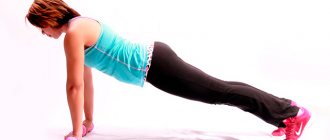How to properly exercise with a fitball?
There are several simple principles for effective training:
- First of all, you need to choose a suitable gymnastic ball, especially for a beginner.
- Conduct classes 1-1.5 hours after eating.
- Before starting the exercises, you need to warm up. This is an important rule for any physical activity. Muscles and joints need to warm up and prepare.
- If you have little experience with a fitball, you can lightly hold the ball with your hands during exercise. Later this need will disappear.
- Fitness classes with a fitball should be carried out at least 2-4 times a week. The duration of one workout is 30-60 minutes.
- If you pump the ball harder, the load during exercise will increase. It will take more effort to impact the fitball.
- It is also recommended to carefully choose the color of the gymnastic ball. It should be pleasant and not negatively affect your mood.
Choosing the right gymnastic ball
To get maximum results, exercise with an exercise ball should be comfortable. The choice of the fitball itself plays an important role in this. The correct size of the ball is determined by the person's height.
Choosing the best option will help you avoid injuries and sprains:
- Fitballs are 45-95 cm in diameter, with an interval of 10 cm. You must subtract 100 cm from your height. The resulting figure is the required ball diameter. For example, if you are 168 cm tall, you need to purchase a 65 cm fitball.
- You can check the ball in another way. You need to sit on it. Bend your knees. So that a right angle is formed. Press your feet to the floor. If these conditions can be met, the ball is chosen correctly.
- It is believed that with a standard height, an adult can safely use a 75 cm fitball. Without the need for calculations.
- The gymnastic ball must not have any mechanical damage. This way it will be quite elastic. This is a necessary condition for obtaining the effect when performing exercises.
- When purchasing a fitball, you should pay attention to the quality of the material from which it is made. Rubber should not have a strong odor. Its density should be quite high. This is necessary to ensure that the ball does not burst during training. The thickness of the rubber should be uniform. This will help prevent the fitball from becoming deformed in the future.
There are gymnastic balls with small spikes. Thanks to them you can get a light massage effect.
What does fitball train?
The benefits of exercising with a fitball are undeniable:
- Helps get rid of excess weight.
- Improves blood circulation.
- Helps speed up metabolism.
- Develops and strengthens the muscle corset.
- Makes joints elastic.
- Perfectly develops the vestibular apparatus.
Thanks to the round shape of the gymnastic ball, movements have a large amplitude. And the instability of the fitball leads to constant muscle tension in order to maintain balance. Excellent for physical activity during the rehabilitation period.
Properties of fitball
Qualities of fitball that lead to weight loss:
- a gymnastic ball is soft and at the same time shock-absorbing, therefore, while relieving tension from the muscles, it simultaneously tones them; other sports equipment does not have this property; even with simple exercises on the ball, fat is burned;
- the ability to roll freely develops coordination and the vestibular system; even just sitting on the ball the body spends a large amount of energy;
- since the ball gives pleasure comparable to children’s games, classes are fun, and you can quietly master significant loads;
- when balancing, muscles work that cannot be used with other equipment, which means weight loss occurs more evenly;
- You can work on specific problem areas, which expands your training possibilities;
- a fitball can be used instead of a chair, for example, when working at a computer, then sedentary work will turn into fitness.
The benefits of exercising on a fitball
Training with an exercise ball is not strength training. But, despite this, they develop general endurance and muscle strength.
They also have a number of advantages over strength or interval training:
- Actively used for people with musculoskeletal problems.
- Suitable for people who are obese or simply overweight.
- Used during pregnancy and for children of any age.
- Used for problems with the cardiovascular system, also for varicose veins.
A set of exercises on a fitball
The intensity of the classes is determined by preparation and physical fitness. The optimal option is: 3-5 approaches, 15-20 repetitions each. It is recommended to start with a load that will not cause discomfort. Over time, you need to speed up the pace of execution and bring the number of repetitions to the optimal level.
Depending on your goals, you can create a suitable training program for yourself.
For belly slimming
- You need to lie on your back. Holding the ball with your feet, lift them vertically. Then lower your feet to the ball closer to your chest and grab the fitball with your hands. Place your hands behind your head and touch the ball to the floor. Take the starting position. Perform the exercise many times, so that the last repetitions are given with great effort.
- Kneel in front of an exercise ball. Knees shoulder width apart. The buttocks are raised above the floor, and the stomach is as tense as possible. Next, you need to roll from your palms to your elbows and back. Do not relax your stomach during the process.
- Lying on the floor, hold the ball with your feet. Raise your legs so that the fitball touches the floor behind your head. Return your legs to their place and repeat the exercise 10-15 times.
For buttocks and thighs
Exercises with a fitball help to engage the entire group of gluteal muscles:
- You need to stand with your back to the ball. Your arms are extended straight out in front of you. Raise 1 leg above the floor to a level of about 20-30 cm. Bend the other leg slightly at the knee and begin squatting. You don't have to sit on the ball. When your buttocks touch the surface of the fitball, you need to straighten up on your supporting leg. Repeat 15-20 times on each leg in turn. During execution, the head is a continuation of the spine and is in line with it. It is advisable to lean the ball against a support so that it does not move during the process.
- From a standing position, firmly grasp the gymnastic ball with your thighs. The spine is straight, the stomach is retracted. Bounce on your toes without releasing the ball. Performing the exercise 20 times is one approach. Just 3-4 approaches.
- Place one foot on the ball behind your back. Perform squats on the second leg. The back is straight, the stomach is pulled in. Repeat 10-12 times on each leg.
- Place the ball in front of you and take a lying position. Raise your feet on the fitball. In such a way that the feet remain in the air. Raise your pelvis up. And roll the ball towards you using your legs. The feet are on the ball, and the body is folded into a kind of triangle. At the highest point, fix this position for several moments. Take the starting position. Perform 10-15 times.
To strengthen arm muscles
- This exercise is very similar to push-ups. The only support in this case is a gymnastic ball. The palms are under the shoulders. Feet are spread wide, toes pointing to the floor. The back remains straight all the time. You need to lower yourself by bending your arms. Elbows should be pressed as close to the body as possible. Return to the starting position and repeat 10 times.
- You need to sit on the ball, legs at right angles, shoulder width apart. In this position, lean with both hands on the ball and move your body forward so that it is in front of the fitball. Now you should do push-ups, lowering your body down, then up. The back should be straight, the stomach should be pulled in.
- Plank on the ball. Feet rest on the floor, hands on the ball. You can do it with your arms straight, or you can bend your elbows. It is difficult to maintain balance on the ball. Shoulders and arms get a good workout. Hold the pose for 30 seconds. Several approaches can be performed. If it is too hard, you can start with less time and gradually increase it.
For the chest
- You need to place your feet on a gymnastic ball. And rest your straight arms on the floor. The whole body is stretched, forming a single line from the legs to the top of the head. The palms are located under the shoulders or slightly wider. From this position you must perform push-ups. If maintaining balance is too difficult, you can lean on the ball with your hips. After adapting to the exercise, move the fitball closer to the feet.
- Lie on the ball, leaning on your shoulder blades. Spread your legs wide and bend your knees. The hips are located below the knees. You should have dumbbells in your hands (choose the weight according to your strength). Bend your elbows slightly and raise your arms above your shoulders. You need to slowly spread your arms to the sides until they reach parallel with the floor. Then raise them again. Perform 12-15 times. The torso should be at an angle of 45 degrees. Otherwise, the load will shift from the pectoral muscles to the shoulders.
- Lie with your shoulders on the fitball. Feet shoulder-width apart, knees bent at 90 degrees. The body is parallel to the floor, without deflection. Take dumbbells in your hands. And straighten them so that the dumbbells are directly above your shoulders. You need to inhale and slowly bend your elbows so that the dumbbells drop to your shoulders. As you exhale, return your arms to their original position. You need to control your movements so that the dumbbells do not hit each other.
- You can use 2 fitballs at the same time. Install them near the wall. Take a lying position, resting each hand on the center of both balls. Inhale and slowly lower yourself down, bending your arms. As you exhale, return to the starting position. Repeat 10-12 times.
For the spine
It will help to form correct posture and get rid of stooping. The work includes muscles that are usually not involved in other exercises.
- Lie with your hips and stomach on the ball. Extend one arm forward and up. The second back, along the body. Her palm is turned up. Change hands. This exercise can be performed in another way: both arms are extended back, palms up. Or both arms are extended forward, with the palms turned inward.
- Lie with your back on the ball. You need to put your hands behind your head and press your palms to the floor. Thus, the body forms a bridge over the ball. Hold this position for a few seconds.
- Lie down on the floor. Place the calves of your straight legs on the ball. Lie like this for about 10 minutes. Breathe freely and deeply. This exercise is very relaxing. You can use it to complete your complex.
For the press
The abdominal muscles work not only during targeted exercises, but also during any others. This happens due to the need to constantly maintain balance. The work also involves the core muscles, which make up the “muscle corset”.
- From a position sitting on the ball, you need to move your legs until your shoulders are on the fitball . Legs are bent at an angle of 90 degrees. The head is supported by weight, but without much tension. The arms are crossed on the chest. Then you need to do crunches. Slowly, so that you can feel the tension in your abdominal muscles. Repeat the exercise 10-12 times.
- Lean your elbows on the gymnastic ball and your feet on the floor at the same time. The whole body is straight, without bending. Rise from your elbows to your palms, resting on the fitball. Then go back. Repeat 10-12 times, 3-4 approaches.
- Place your hands on the floor and place your feet on an exercise ball. Pull your knees as close to your chest as possible. Then straighten your legs again. Perform the exercise 10-15 times.
- Take a push-up position. The only difference is that the feet are on a fitball. All muscles are tense, the body is straight. Leave one foot on the ball and lower the other slightly. From this position you need to twist, trying to bring your knees and shoulders as close as possible. Repeat the exercise 10 times for each side.
For the back
- You need to lie on the fitball with your stomach down. Place your palms on the floor, shoulder-width apart, and lean on them. Then move forward a little, moving your hands step by step. So much so that your knees are on the ball. Feet together, palms under shoulders, body straight. Having reached this position, you need to lift your pelvis up until your feet are on the gymnastic ball. You can't bend your legs. Next, you need to slowly lower yourself to the starting position. Perform 10-12 times.
- The stomach and hips are placed on the ball. Legs are straight, toes rest on the floor. Hands are placed behind the head. It is necessary to raise your chest high, stay in this position for a while and return to the starting position.
- Lie on your stomach on the fitball. Place your straight arms on the floor. The shins are on the ball. You need to move forward and backward using your hands.
Exercises on a gymnastic ball for infants and children
For infants and children, such activities bring no less benefits than for adults.
They are helping:
- normal functioning of the nervous system;
- proper development of the musculoskeletal system;
- development of flexibility;
- strengthening the immune system;
- improving the functioning of internal organs;
- help stimulate gastrointestinal motility.
For babies up to six months
- Place the child with his stomach on the gymnastic ball. Gently rock it to the sides and back and forth, holding it by the arms and legs. You should not pull the baby by the feet or hands, as the joints are not yet strong.
- Place the child's back on the fitball. Rock it from side to side, holding your stomach and chest with your palms.
- Hold the child lying on the ball by both legs. At the same time, lightly press the ball, putting pressure on the baby’s body. All movements must be very careful. You can do the exercise both on your back and on your stomach.
From six months to one year
- It is necessary to hold the child with your palms by the body above the gymnastic ball. And, without letting go of your hands, give him the opportunity to jump on the fitball. You can do this until the child gets tired.
- Place the baby on his stomach. Take him by the legs and pull him towards you, bending him at the knees. Then pushing them away from you and straightening them at the same time.
- Place the child stomach down on an exercise ball. So that he can rest his hands and his body is raised. Holding your legs, swing them in different directions.
- Child on fitball. Lying on his back. Take him by the legs and gradually lower him until he can touch the floor or pick up something from it.
It is important to know:
- You cannot work with children earlier than 1-1.5 after eating.
- Do not exercise when you have a high temperature or when you are sick.
- Start with small loads and increase them gradually.
- Do not exercise if the umbilical wound has not yet healed.
- It is recommended to consult a pediatrician before starting classes.
Exercises
This sports equipment allows you to perform a wide range of exercises. Exercises for strengthening the back muscles and abdominal muscles are more in demand - use the video lessons. Features of the position and amplitude of body movements help strengthen the muscular corset of the back with a gentle load on the spinal column, while simultaneously developing all muscle groups, and all this at home.
For the spine
Exercises on a fitball for the back according to the Bubnovsky method:
- We lie down with our stomachs on the fitball, touching the surface of the floor with our limbs. Maintaining balance, we alternately raise our arms and legs.
- We perform rolls, moving our hands along the floor until our hips touch the fitball. Then we roll in the opposite direction until the chest feels the equipment. Promotion on the back is performed in the same way. In case of spinal hernia, the second option is excluded.
- The method of extension is hyperextension on a fitball. Exercise helps relieve back pain. Performing the technique with a fitball is a ladies' option. We rest our lower limbs against the stationary part, and lie with our hips on the ball, taking a parallel body position in relation to the floor. We hold our hands to the sides. Now you should tense your buttocks and lift your body up as you inhale, and slowly lower your body down as you exit.
- The next technique is called crunches and is also suitable for training the abs. Now the back will become the supporting surface. So: legs bent at the knees, hands held with palms behind the head or on the chest. We stretch our chin upward as we exhale.
For the pelvis
This task is indicated for the development of motor capabilities of the pelvic bones. We take a sitting position on the fitball. And we alternately perform rolling movements according to the trajectory forwards, backwards, and to the sides. Then we perform rotational movements with our hips on the ball. We finish the exercise with light jumps.
For the press
The task of the next complex is determined by strengthening the muscular part of the organs that ensure extension of the spinal system and pumping of the abdominal press. We lie on our backs on the mat. We hold the ball between our legs. Palms rest on the floor. Raise the ball up as you exhale, trying to lift your pelvis and move the ball behind your head. While inhaling, return to the starting position.
Next, we lie down with our shoulder blades on the fitball, with our legs bent at the knees and resting on the floor. Straighten your right arm and left leg. As you exhale, reach your hand towards your leg, and as you inhale, return to the starting position. Repeat with the other leg and arm.
Buttocks and legs
Now let's move on to the buttocks and legs. To do this, lie down on the mat on your back, shin on the ball. As you exhale, we lift the pelvis and lift the left leg off the ball, the right leg pulls the ball closer to the pelvis. While inhaling, we return to the starting position. Same thing with the other leg.
Next exercise. We lie down on the fitball on our stomach, resting our elbows on the floor. We keep our legs suspended and lift them up one by one.
Stretches and balance on a fitball
An important point in the final stage of any workout at home is stretching the working muscles. To do this, we lie down on an elastic ball with our backs, stretch our legs forward and slightly spread them. The feet are pressed tightly to the floor. We stretch our arms up and hold, breathing evenly. Proper, calm breathing promotes a feeling of stretching in tense muscle fibers. There is no need to overexert yourself, especially for beginners.
The second task involves developing the ability to maintain balance. Having fixed a sitting position on the ball, we spread our arms to the sides, raise one leg, and the second performs a supporting function. We begin to carefully spring in place. Then we perform the familiar body rolling. You should repeat the movement technology with support on the other leg.
Exercises on a gymnastic ball for pregnant women
Gymnastics on a fitball for pregnant women involves several positions:
- Lying down.
- Sitting.
- Standing on all fours.
A few simple exercises that are basic and have tangible benefits for the body of a pregnant woman:
- Spring. It is performed while sitting and involves springing movements, keeping your feet on the floor. You can complicate the exercise by raising your arms up or adding body rotations.
- Butterfly. It is performed lying down and serves to work the inner and outer muscles of the thighs. From a position lying on its side, the ball is grasped with the legs, and at the same time squeezing movements are performed
Workout
Exercises for weight loss are designed to work all parts of the body, they can be done daily, or every other day. When training three times a week, weight loss should be about five kilograms per month. To relax, you can jump around the room between exercises; for this activity it is better to have a ball with handles.
- Warm-up, walking exercises - side steps, turning the ball in your hands (hold at shoulder level) in the direction of movement, 30 times. Walking in place with knees raised high - 60 times. While walking, lift the ball above your head, squat 15 times with the ball on outstretched arms. To relax, jump around the room on a ball.
- Hips training - standing, squeeze the ball as tightly as possible with your hips in a standing position, hold the position, keeping your back straight and your stomach pulled in. Jump 20 times on your toes without releasing the ball, do four approaches.
- Buttock lift - place one foot on the ball and squat 10 times on the other leg, pulling in your stomach, repeat on the other side.
- Place your shins on the ball and do push-ups from the floor five times with your palms wide apart and five times with your palms shoulder-width apart.
- Place your feet on the ball, palms of your hands on the floor, pull in your stomach, bring your shoulder blades closer to each other, stretch yourself like a string and hold on for a minute. For the second minute, alternately stretch your arms up, maintaining a straight body position. In the third minute, stand with your toes on the ball and try to make an upward angle between your legs and body, slowly straighten up again.
- To lose belly fat, lie on your back and hold the ball between your shins. Pull the ball to your chest, pick it up and place your hands behind your head, touching the ball to the floor. Work until exhaustion; determine the number of approaches yourself, based on your capabilities.
- Lying on your back, grasp the ball with your calves and, tensing your abdominal muscles, pull it to your chest, trying to simultaneously raise your head and shoulders.
- Place your elbows on the fitball, toes on the floor and straighten up. Roll from palms to elbows and vice versa, maintaining a straight body position.
- Feet on the floor, sit on the ball. Place your hands behind your head and slowly roll the ball towards your shoulder blades, balance for a minute, then lift one leg in turn and try to maintain balance on the other.
- Standing on your hands, the ball is under your shins. Bend one leg and roll the fitball to your shoulders with your knee and return to the starting position.
Of course, classes are effective not only for losing weight, but also in general for improving health and raising tone, mood, and overcoming stress. Be sure to do a warm-up, warming up your muscles, and do stretching exercises after class. Exercises need to be performed 10 - 15 times. Between exercises or approaches, you need to train your heart - run, jump rope, or simply jump on a gymnastic ball with a handle, then the effectiveness and speed of weight loss will increase significantly.










